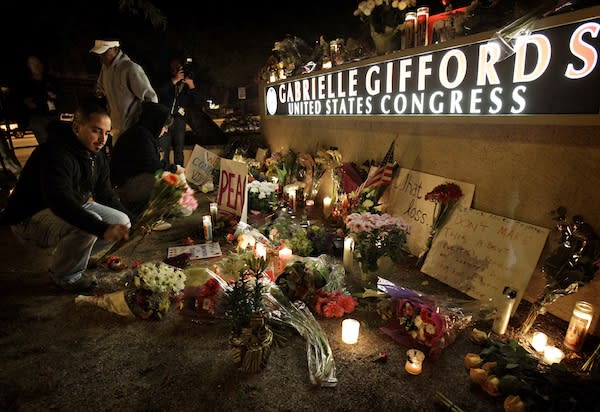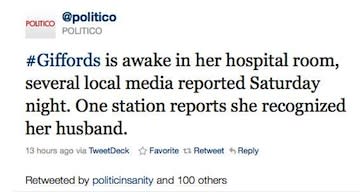 The Cutline
The CutlineMedia faces scrutiny after inaccurate Giffords reports

Journalists are familiar with an old motto: "Get it first, get it right." But in the midst of a national tragedy and ensuing media frenzy, some news organizations got one major fact very wrong—that Rep. Gabrielle Giffords had died shortly after the Tucson shooting.
Six people were killed in the shooting rampage, including a federal judge and a 9-year-old girl. Giffords, however, wasn't one of them. As of Sunday morning, she remains in critical condition.
Craig Silverman, who runs RegretTheError.com, put together a timeline of misinformation spread by news organizations and individual journalists over Twitter. It appears that NPR was the first outlet to inaccurately report that Giffords had been killed. NPR's report was then quickly cited by other media outlets and spread by Twitter users (including the Yahoo! home page and The Ticket blog on Yahoo! News, which briefly reported Giffords' death citing NPR).
NPR spokeswoman Anna Christopher told Politico
Saturday night that the news organization regretted the "erroneous news" and explained that their reporters had two sources confirming the report. But NPR wasn't alone. Both Reuters and CNN independent reported that Giffords was dead. And Mediaite's Rachel Sklar noted that the New York Times also briefly reported that Giffords was dead in a news story while the paper's homepage said the situation was "still unclear." Fox News also reported she was dead.
Although news organizations quickly offered retractions, the inaccurate reports were widely disseminated and even made their way to Giffords' husband Mark Kelly, according to a friend of the couple on Sunday's "Good Morning America."
The Tucson shooting has already sparked discussions about the use of violent political imagery—such as Sarah Palin putting Giffords' Arizona district under the crosshairs of a gun—and the heated rhetoric used by some talk radio and cable news hosts.
But the tragedy may also provoke conversations in newsrooms about how rushing to advance a rapidly moving story can lead to grave mistakes. NPR's Christopher also told Politico that the network has "already started internal discussions into the sequence of events in deciding to report that she had been killed."
A few hours after the shootings, Salon's Dan Gillmor urged media outlets to "take a slow-news approach."

"The reports from traditional news organizations, amplified by Twitter, blogs and other Internet media, have been a parade of unclear information—just just what we've come to expect in such situations," Gillmor wrote, noting early reports that Giffords had been killed.
Gillmor also posed questions for both for news organizations and news consumers: "What is it about breaking news that causes us to turn off our logical brains? Why do we turn on the TV or click-click-click Refresh or scan the Twitter feeds to get the very latest details—especially when we learn, again and again, that the early news is so frequently wrong?"
But just hours after Gillmor's post, several news outlets got another fact wrong—that Giffords was awake and had recognized her husband in the hospital. Silverman then updated his early list of inaccuracies to include these reports, along with outlets such Politico amplifying the erroneous news on Twitter.
"Giffords NOT awake and recognizing husband," The Nation's Greg Mitchell tweeted early Sunday morning. "Another media error."
(Photo of candlelight vigil outside the offices of U.S. Rep. Gabrielle Giffords on Saturday, Jan. 8, 2011 in Tucson, Ariz: AP /Matt York)

